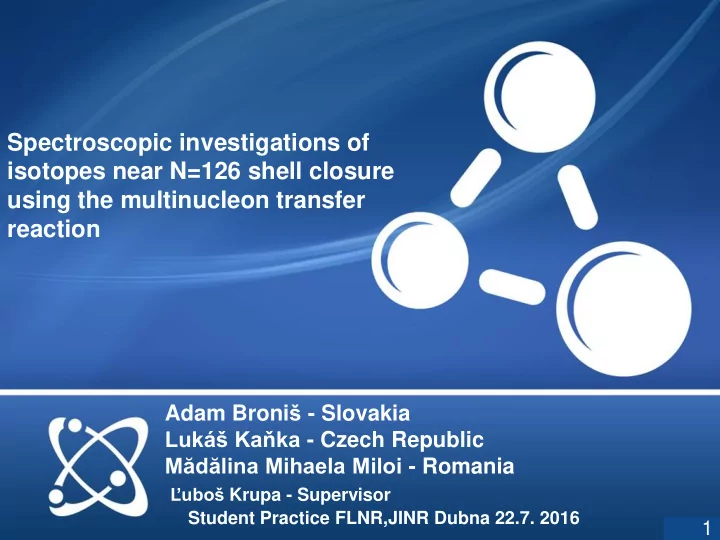

Spectroscopic investigations of isotopes near N=126 shell closure using the multinucleon transfer reaction Adam Broni š - Slovakia Lukáš Kaňka - Czech Republic Mădălina Mihaela Miloi - Romania Ľuboš Krupa - Supervisor Student Practice FLNR,JINR Dubna 22.7. 2016 1
Main goals • The aim of the project was analysis of data from experiment and to determine cross sections of Radon isotopes. These results could provide a better understanding of structure and properties of superheavy elements and information about their synthesis. 2
Content 1. Transfer reactions 2. Experimental setup 3. Data analysis 4. Conclusion 3
Transfer reactions • Direct -one stage proces • Non-uniform angular distibution of products (conservation of angular momentum) 10 22 • Time scale s Transfered cluster X Projectile X b (impact factor) n p Target nucleus Three body problem – projectile, target, cluster DWBA (Distorted wave Born approximation) - incoming and outcoming planar waves are distorted by the nucleus due to the optical model 4
Transfer reactions Two types of transfer reactions were used in the experiment: 48 208 X • Ca Pb Rn .... • 48 242 X Ca Pu Rn .... X=211,212,219,220,221,222 Projectils Targets Multinucleon transfer products Different isotopes of radon (with different masses) are produced. Mass differences and energies are used for their separation and identification. 5
Experimental setup MASHA (M ass A nalyzer of S uper H eavy A toms) capabilities: • measuring the masses of synthesized superheavy element isotopes • simultaneously measuring their decays and spontanneous fission • determination yields of isotopes 6
Experimental setup Mass separator MASHA Quadrupole lenses Hot catcher Detector Dipole magnets ECR ion source Focal plane 7
Experimental setup Hot catcher After emission from the Separating foil target the reaction products passed through the separating foil and stopped in a graphite foil heated up to 2000K. Then the products diffused from the graphite into the vacuum of the hot catcher and continued to to ECR ECR source. Heater Graphite foil Target 8
Experimental setup Electrostatic deflector for energy separation Bending magnet for separation Isotopes are separated according to their masses and finaly implanted in focal plane silicon detector Different isotopes Beam Beam of radon correcting focusing Pair of main magnets elements lenses for ion separation and mass resolution 9
Experimental setup Focal plane silicon detector 16 strips 64 strips 64 strips Frontal part of the detector - 192 strips 16 strips All strips are equally thick 300 micrometers. Energy resolution for particles is approximately 30 keV. During measurements just the 47 % frontal partal of detector was used. Efficiency was due to detector geometry. 10
Data analysis 2D spectra of the particle energy vs strip number in the frontal part of the detector 9 8 E [MeV] 7 6 5 4 0 50 100 150 192 Strip 211 212 Rn Rn 219 220 Rn Rn 11
Data analysis σ 2 π p 0 N B 12
Data analysis Simulations We used system of differential equations simulation to get the counts of isotopes: dN ( ) t λ 1 N ( ) N (t) t 1. 1 1 p t dt λ N * N α1 1 1 dN ( ) t t 0 λ λ 2 N ( ) N ( ) * 0.47 t t 2. 2 2 1 1 dt N (t) k * I B dN ( ) t p p λ λ 3 N ( ) N ( ) t t 3 3 2 2 dt 3. dN ( ) t λ λ 4 N ( ) N ( ) t t 4 4 3 3 dt 4. ……………… 13
Data analysis Counts 1. Decay data 1. Decay simulation 2. Decay data 2. Decay simulation 3. Decay data 3. Decay simulation Time [s] 13
Conclusion The simulation by means of the system of differential equations proved to be a valuable tool for analysis of this particular problem. It corresponds with the data from the experiment and provides the real count of particles on the detector. Based on the count of all isotopes cross-sections can be subsequently determined. 15
Thank you for your attention. 16
Recommend
More recommend